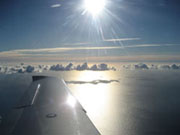Where everything begins
The Private Pilot License (PPL FAA) is certainly the most important licence, because all other license will conseguently be added to it. Ask any private pilot if he remembers his instructor, and he will surely respond that he is still in touch with him, even after several years.
The memories that a pilot keeps of this stage are engraved on his mind for his/her life. This is where we first discovered the sensation of flight, our first takeoff, our first solo flight, alone in the aircraft after only a few hours, our first navigation prepared for hours and hours, finally arriving at exactly the point we wanted at the estimated time, it is also our first go-around after a gust of wind on short final thought rightly too strong for us, or after bouncing 2 or 3 times on the runway. In short, that is when we will learn all the basics of flight and the behavior required never to exceed our limits, even if they improve in the future. Safety is gained through learning such judgments, very different from those we have on land!
Stress management in flight is also a key element to understand in order never to be caught short of finding solutions, whatever the event, and such events do occur! This can range from engine failure just after takeoff, the worst situation a pilot can find himself in, to the simple application of rules of priority during an integration in a traffic pattern with an other aircraft in front of you, or when you must turn back in a situation in which the weather deteriorates without having being forecasted. More than the handling of an airplane in 3-dimensional space, it is in such a situation that occurs during your private pilot training that you will learn how to develop your judgment, and that is why it will always remain the most important license.
The privileges of the Private Pilot License (PPL FAA)
Once you have gained you license, you can fly all single engine aircraft registered in the United States (ie, with a registration that starts with N on the tail of the aircraft), all over the world!
You can fly day and night, alone or with passengers, but you should stay away from clouds and marginal weather conditions, and you cannot charge for your pilot services, these two limitations being the purpose of other qualifications and licenses (see the IFR FAA and CPL FAA).
It is also worth noting that if you do your training on a single-engine airplane, which is more than highly recommended to start with, then you must pass an other class qualification, the multi-engine rating (see MEP FAA in the other training section) to use your license on twin-engine aircraft, like the DA42 or Baron for example.
The only requirement to keep your license valid is to make what is called a Biennial Flight Review (BFR) every two years, with an FAA instructor. This is a flight check that may result in additional training to re-obtain to the skills you had the day of your test.









